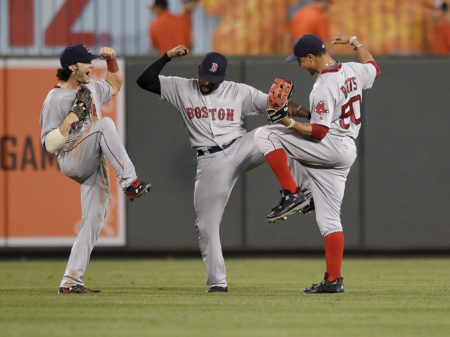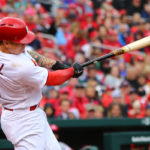Gulliver and the Lilliputians at the World Series
 The Regular Season
The Regular Season
This past baseball season felt like it was played in a test tube that was continually jolted and prodded with every bullet thrown to home plate. Try as hard as they might, the Lilliputians could not play the game the way Gulliver did. And in a season that augured in a redefinition of pitching roles (relievers used in the first inning; closers used in other than ninth inning closing situations, and even some starters called upon as relievers whenever the need arose), the Lilliputians found new ways to win some games, but despite their creative plug-and-play solutions, and their bevy of triple-digit pitchers who could be called upon, it still was not enough to topple Gulliver. But, the new hurlers were enough to confuse not only hitters but catchers and even umpires on occasion, as was witnessed by the many heated discussions over balls and strikes enacted on the stage around home plate.
So, these triple-digit pitchers hurled bee-bees to the plate in the guise of two-seamers, four-seamers, cutters, sliders, change-ups, curve balls, and even the occasional knuckle ball that floated in and out, and all of these heaves arriving at home plate with an unprecedented precision characteristic of the new age of pitching.
Triple-digit pitchers without roles.
The pitcher as an interchangeable piece.
The new plug-and-play solution.
And of course, as has become the custom, almost every team is flush with several magicians ready to unleash triple-digit heat whenever their manager calls their number.
That’s the evolution of triple-digit pitching. From Walter Johnson in the 1920s to Justin Verlander just short of the 2020s. Harder and harder throwers with better and better secondary pitches to confound the hitter. It’s no wonder that even the finest hitters occasionally lunge with futility at pitches that gyrated ferociously as they veered off the plate at the last possible moment. Strikes for a fleeting interval that became balls until the hitters flailed away and the pitch became a strike again.
Some of these triple-digit pitches were so wicked the catcher had no chance to smother the ball in his chest protector if it bounced before the plate or sailed over his head. And, once their feeble attempts proved ineffective and the ball scattered past them like pinballs inside a machine caroming out of control as bells and whistles went off with each unintended bump, all they could do was turn and run.
Whip off their masks as the ball finally settled in some nook or cranny, after frenetically buzzing into a wild curlicue of frenzy behind the backstop. Order was restored once the catcher gripped the ball, fully prepared to enforce justice, again.
Skulking back to home plate, the catcher shook his head. One more notch on his catching resume. A passed ball. A wild pitch. The dreaded triple-digit pitch. And the pitching plan he had been told to oversee was now full of holes. The catcher knew this as he gently tossed the ball back to the glum-faced pitcher halfway off the mound. The triple-digit pitcher cupped the ball in his hands and vigorously rubbed it up, as if it was covered with secret incantations that only he could counter, before he received his next sign, readied himself, toed the rubber, and began the pitching cycle anew. The high-speed magic act continuing.
No wonder this has been the craziest of seasons. More swings and misses and more strikeouts than ever before in one season in the history of the sport.
And it’s this 2018 season that’s finally reached its ultimate stage. The last seven games.
The World Series.
Gulliver facing one of the Lilliputians set to do battle into the chill of November. If it goes that far.
The Postseason
The American League Championship Series was unusually one-sided this year. One might even say the entire post-season has been topsy-turvy because the regular season played as if it was a modern Gulliver’s Travels. A story of a few giants traversing the land of Lilliputians and their quaint stadiums, as they plundered all the wealth they found in their midst.
But of those Gulliver’s, one was more giant, ferocious, and resilient than all the others. And when that massive Gulliver left town not only were the locals glad to see him go, but their triple-digit pitchers breathed easier, emerged out into the sunshine, and showed their faces again. For there was no shame losing to the best of the best. Once the best had gone.
This monstrous Gulliver was the Boston Red Sox.
When those 25 Bostonians came to town, their opponents faced a glut of strikeouts. Barren innings. And perhaps worst of all, a false sense of hope. Their initial belief they could topple the Bostonians was proven wishful thinking time and again. Just when the locals thought they had the Red Sox licked and on the run, the Red Sox stormed back. Laughed at their opponents’ fickle Lilliputian presumptions, and then battered their offerings. Splattering orbs off walls, over walls, around walls, between fielders, and where the fielders ain’t. And as the Bostonians practiced their craft, and more of them touched the pentagon at the heart of the game (otherwise referred to as home plate), the Lilliputians suffered loss after loss.
It seems every opponent this past year experienced their own traumatic moment at the hands of Gulliver. Even the lesser Gullivers, like the New York Yankees and Houston Astros (whom Gulliver handily disposed of in the American League Championship series last week), had their hopes squashed several times during the season. Embarrassed.
Bludgeoned would be a better description.
Flattened like a pancake.
In early August, the Red Sox pummeled the Yankees 15-7 in the opening game of a crucial four game series in Fenway that defined the rest of the season for both teams. That first game was not even as close as 15-7, especially since the Yankees jumped out to a 4-0 lead the first few innings before the roof caved in on their not triple-digit pitcher CC Sabathia. And from there on, the Yankees could not extinguish the blazing fire that consumed the rest of their season.
And, then again in the Division League playoff series, Gulliver won the deciding third game in a resounding explosion. A 16-1 victory. Stunned Yankees could only go through the motions. The stuffing kicked out of them. A clear statement of who’s who. And the Lilliputians not only went quietly, they were fully aware who was best. And the hated, vulgar secret was no longer private.
Now Gulliver faces yet another Lilliputian on his travels to the World Series. And it’s the opinion here that they will find their final resting place atop the mountain, looking down on all the other Lilliputians, as they head into the clouds for the final time this season. Champions. Regardless of the triple-digit pitchers the Lilliputians send to the mound.
Gulliver in five games.

























